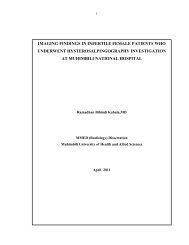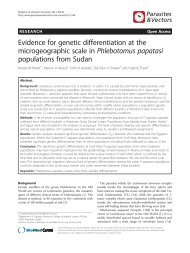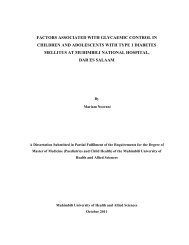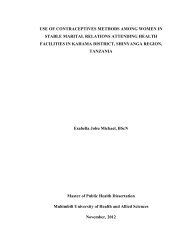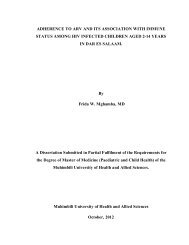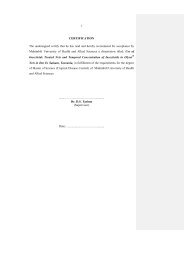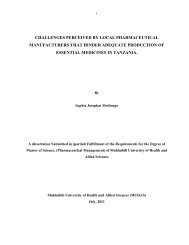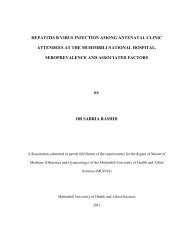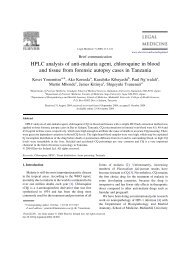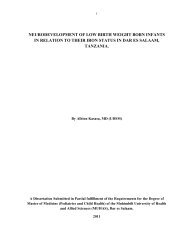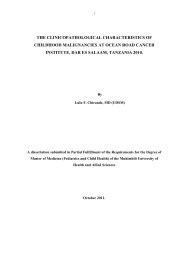DISSERTATION WORK MSAFIRI KABULWA.pdf
DISSERTATION WORK MSAFIRI KABULWA.pdf
DISSERTATION WORK MSAFIRI KABULWA.pdf
Create successful ePaper yourself
Turn your PDF publications into a flip-book with our unique Google optimized e-Paper software.
1<br />
1. INTRODUCTION<br />
Tobacco can be used in various forms; it can be smoked, chewed, sniffed or dipped. In<br />
whichever the form it is used, tobacco releases nicotine which is a stimulant that increases<br />
activity in the brain just like caffeine, cocaine and amphetamine (Jarvis 2004, Jha et al 2006).<br />
The stimulant effect of nicotine to the brain creates the desire for a person to continue using<br />
tobacco until one becomes addicted therefore being exposed to harmful effects of other<br />
chemicals present in tobacco (Jarvis 2004, Dennis et al 2005, Jha et al 2006, Jiloha 2010).<br />
Unfortunately, in addition to nicotine other antigenic, cytotoxic, mutagenic and carcinogenic<br />
chemicals that are harmful to oral and general health are also released (Behr and Nowak 2002).<br />
The release of these harmful chemicals from tobacco may explain why tobacco use has been<br />
strongly associated with oral cancer (Johnson and Bain 2000, Reibel 2003, WHO 2003a),<br />
increased susceptibility to periodontal diseases (Borrell and Papapanou 2005, Do et al 2008),<br />
reduced response to periodontal therapies (Tonetti et al 1995) and increased risk of dental<br />
implant failure (Bain and Moy 1993). Other adverse effects of tobacco use on oral health<br />
include tooth staining and halitosis (Johnson and Bain 2000). On general health, tobacco use<br />
especially tobacco smoking has been associated with occurrence of lung cancer and<br />
cardiovascular diseases (van der Vliet and Cross 2000, Shammas 2007).<br />
In Tanzania oral cancer is a public health problem because most of the cases diagnosed with<br />
oral cancers come to hospital at late stages of the tumors when the lesion has exceeded the size<br />
that can be treated by conservative surgical approach. Consequent to late diagnosis majority of<br />
the cases are treated by radical surgical intervention or palliative care which causes extensive<br />
disfigurement leading to poor quality of life (Cubey 1974, Dandapat et al 1992). In addition<br />
globally, the post operative survival life span of cases with lesions greater than 2cm in diameter<br />
is short, in most cases not exceeding five years from the disease onset (Hindle and Nally 1991).<br />
Therefore, majority of oral cancer patients who report late are likely to die within five years<br />
after surgical/medical intervention. In cases where patients report at very late stage of the<br />
disease only palliative radiotherapy is given as part of terminal care. There is a need to institute<br />
appropriate intervention to reduce the occurrence of oral cancer in Tanzania. Likewise



